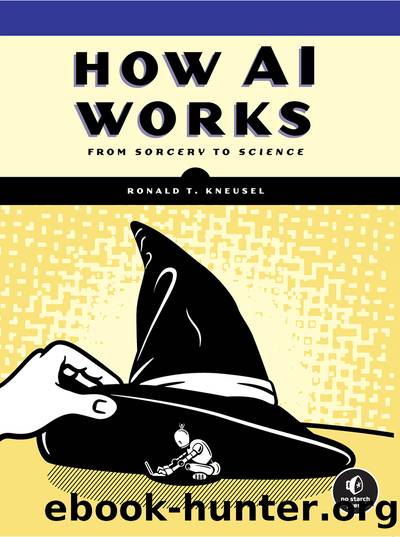How AI Works: From Sorcery to Science by Ronald T. Kneusel

Author:Ronald T. Kneusel
Language: eng
Format: epub, pdf
Publisher: No Starch Press, Inc.
Published: 2024-10-15T00:00:00+00:00
Figure 5-1: Example MNIST digits (top) and scrambled versions of the same digits (bottom)
The scrambled digits are incomprehensible to me. The pixel information between the original and scrambled digits is the sameâthat is, the same collection of pixel values is present in bothâbut the structure is largely gone, and I can no longer discern the digits. I claim that a traditional neural network treats its inputs holistically and isnât looking for structure. If thatâs the case, a traditional neural network shouldnât care that the digits have been scrambled; it should learn just as well when trained using the original or the scrambled dataset. As it turns out, thatâs precisely what happens. The model learns equally well; scrambling changes nothing in terms of performance. Note, though, that the scrambled test digits must be used with the scrambled model; we shouldnât expect the model to work when trained on one dataset and tested on the other.
We at present know only one fact about CNNs: they pay attention to structure in their inputs. Knowing this, should we expect a CNN trained on the scrambled dataset to perform as well as one trained on the original dataset? The scrambled digits are uninterpretable by us because local structure in the images has been destroyed. Therefore, we might expect a model that similarly wants to exploit local structure to be unable to interpret the scrambled digits. And that is the case: a CNN trained on the scrambled dataset performs poorly compared to one trained on the original dataset.
Why canât we easily interpret the scrambled digits? We must explore what happens in the brain during vision to answer that question. Then weâll circle back to relate that process to what CNNs do. As weâll learn, CNNs follow the old adage: when in Rome, do as the Romans (humans) do.
****
Vincent van Gogh is my favorite artist. Something about his style speaks to me, something strangely peaceful from a man tormented by mental illness. I believe the peace emanating from his work reflects his attempt to calm the turmoil within.
Consider Figure 5-2. It shows Van Goghâs famous 1889 painting of his bedroom in Arles. The image is in black and white, an unforgivable violence to Vincentâs use of color, but print restrictions require it.
Download
How AI Works: From Sorcery to Science by Ronald T. Kneusel.pdf
This site does not store any files on its server. We only index and link to content provided by other sites. Please contact the content providers to delete copyright contents if any and email us, we'll remove relevant links or contents immediately.
| Computer Vision & Pattern Recognition | Expert Systems |
| Intelligence & Semantics | Machine Theory |
| Natural Language Processing | Neural Networks |
Algorithms of the Intelligent Web by Haralambos Marmanis;Dmitry Babenko(16280)
Jquery UI in Action : Master the concepts Of Jquery UI: A Step By Step Approach by ANMOL GOYAL(9408)
Test-Driven Development with Java by Alan Mellor(7737)
Data Augmentation with Python by Duc Haba(7612)
Principles of Data Fabric by Sonia Mezzetta(7381)
Learn Blender Simulations the Right Way by Stephen Pearson(7296)
Microservices with Spring Boot 3 and Spring Cloud by Magnus Larsson(7139)
Hadoop in Practice by Alex Holmes(6589)
RPA Solution Architect's Handbook by Sachin Sahgal(6519)
The Infinite Retina by Robert Scoble Irena Cronin(6218)
Big Data Analysis with Python by Ivan Marin(5937)
Life 3.0: Being Human in the Age of Artificial Intelligence by Tegmark Max(5520)
Pretrain Vision and Large Language Models in Python by Emily Webber(4897)
Infrastructure as Code for Beginners by Russ McKendrick(4658)
Functional Programming in JavaScript by Mantyla Dan(4441)
WordPress Plugin Development Cookbook by Yannick Lefebvre(4386)
The Age of Surveillance Capitalism by Shoshana Zuboff(4252)
Embracing Microservices Design by Ovais Mehboob Ahmed Khan Nabil Siddiqui and Timothy Oleson(4149)
Applied Machine Learning for Healthcare and Life Sciences Using AWS by Ujjwal Ratan(4136)
